Bromeliad Blooms: The Best of the Best
Author: Melanie Dearringer2 Comments

Many bromeliads are known for their foliage. They have lovely rosette shapes and often brilliant colors with interesting variegation. However, some bromeliads also showcase a stunning inflorescence.
Bromeliads take a long time to mature. If you start with a young plant, it can take years before your bromeliad begins to bloom. However, many that are found at nurseries and garden centers are sold just before or right as the plant begins to bloom. When you choose the right species of bromeliad, you can enjoy beautiful blooms that sometimes last up to several months.
Only One Bloom
Keep in mind that most bromeliads only bloom once. After which they will focus their energy on producing pups or offsets. These pups are exact clones of the mother plant. So while the original bromeliad may only bloom once, maintaining and caring for the offspring your plant produces will allow you to enjoy several generations of beautiful blooms. For more information on pups, download our free Beginner’s Guide to Bromeliad Pups.
Shapes and Styles
Bromeliad flowers come in a number of shapes and styles. They can stand tall, towering over the foliage, hang from the side of the plant, or hide nestled deep in the central tank. Bromeliad inflorescences can be found in a myriad of colors.
Species
Some of the most attractive and brilliant inflorescences are found among the Aechmea and Vriesea genera of bromeliads. Here are a few bromeliad species that are easily considered some of the showiest, most attractive, and most unique around.
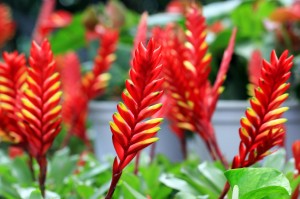
-Vriesea splenden
Vriesea splendens, better known as flaming sword, is named for its brilliant inflorescence. The broad flat inflorescence is bright red and rises up to two feet tall. Small, tubular, yellow flowers protrude from the red bracts. This beautiful inflorescence can last for several months. In addition, to the vibrant bloom, Vriesea splendens also has beautifully variegated foliage. Each leaf is horizontally banded by deep maroon stripes.
Vriesea splendens is a fairly common bromeliad and can be found readily at garden centers. The flaming sword is easy to grow indoors and can be grown terrestrially in a pot or mounted as an epiphyte. Water the plant in its central tank and be careful not to over-water.
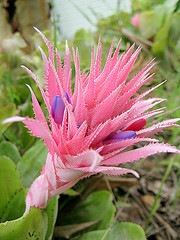
-Aechmea fasciata
Aechmea fasciata, commonly known as urn plants or silver vase plants, are popular bromeliads. They are slow growing and can become quite large. Their broad leaves are a dusty green with powdery silver, horizontal banding. The inflorescence is light pink and ball shaped and is framed by several larger pink bracts. Small dark pink or purple flowers emerge from the center of the inflorescence. Aechmea fasciata can take up to five years to reach maturity.
This plant does well potted and should be watered in its central urn. It prefers bright indirect light. It will tolerate lower light levels, but it may take considerably longer to produce a bloom.
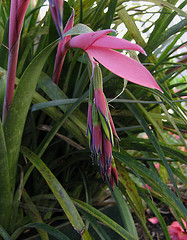
-Bilbergia nutans
Bilbergia nutans is also called queen’s tears because of the way the flowers drip nectar. This is a very easy plant to grow and is ideal for the beginner bromeliad collector. Its flowers hang in pendant form from a long pink flower scape. The flowers are truly uniquely shaped. The petals,yellow-green in the middle and edged with blue, roll back to reveal long yellow stamens. These intricate bundles of flowers last for about six weeks and usually set on in the spring. Bilbergia nutans is also referred to as the friendship plant because it generously produces pups that can be passed on to friends.
Queen’s tears likes the shade in the summer and will thrive in bright indirect light the rest of the year. It prefers humid conditions and can be kept moist with misting.
Quesnelia quesneliana produces pretty, uniformly round, pinkish red flower bracts. It has an almost honeycomb appearance that rises just slightly above the foliage. Brilliant blue flowers emerge from the bracts. This plant is an ideal landscape plant. It can tolerate temperatures slightly below freezing and is also drought resistant.
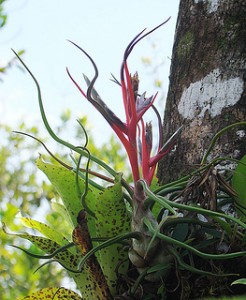
-Tillandsia bulbosa
Tillandsia bulbosa is a bizarre looking plant. It has skinny leaves that curve and twist out of a bulbous base. The plant is only a few inches tall and wide. It produces bright red bracts from the center of the plant. The bracts send out small tubular flowers that are purple in color. This plant propagates quickly and creates large masses of flowering bundles.
Tillandsia bulbosa is an air plant and should be mounted on a substrate. A daily misting will provide the moisture this plant needs.
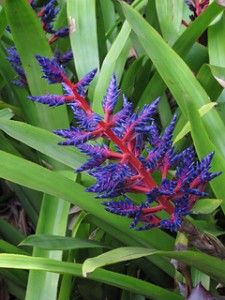
-Aechmea ‘Blue Tango’
Aechmea ‘Blue Tango’ is a relatively new hybrid. This plant produces an electric inflorescence of hot pink and bright blue. The flower stalk stands high above the foliage and bears hot pink branches of small, brilliant blue bracts. The inflorescence on this plant is truly spectacular.
This cultivar can be grown indoors or as a landscaping plant in warmer climates. Bright, indirect light is ideal for this plant.
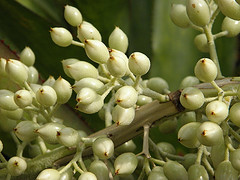
-Aechmea mexicana
Aechmea mexicana is a very large species of bromeliad that features a showy white inflorescence. The broad leaves form a large wide rosette. The flower stalk shoots up from the middle of the plant and produces many blue and purple tinged powdery berries. The inflorescence is covered in tiny scales that give it a white appearance.
This plant requires bright light and its foliage will blush orange-red with direct sunlight. This bromeliad does best as a landscape plant in warm climates because it requires so much space and light.
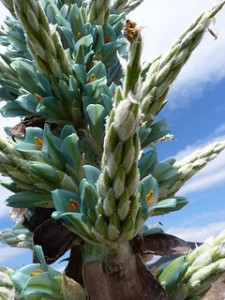
-Puya berteronaia
Puya berteronaia offers a giant club like inflorescence that produces hundreds of turquoise, three petaled flowers. The turquoise complements its bright orange stamen beautifully. Puyas are native to Andean hillsides and can tolerate colder temperatures than most bromeliads. They also prefer very dry climates. Their foliage is thin and light green resembling large clumps of ornamental grass.
While the flowers on this plant are spectacular, they require significant patience. It can take ten years or more to produce a mature plant that will flower.
Tillandsia chlorophylla grows about 12 inches wide and produces a 12 inch tall showy flower stalk. Its inflorescence is branched and bright red. The end of each branch boasts a tubular bluish purple flower. This is one of few Tillandsia species that can be either potted or mounted.
Some of these blooming bromeliads are ideal for growing yourself indoors, while others may be best enjoyed when visiting a botanical garden. There are many species and variations of bromeliads that offer beautiful and intricate blooms.
Did we leave your favorite off the list? Let us know which bromeliad bloom you enjoy the most and why.
Sources
“Tillandsia chlorophylla” Tropiflora. <http://www.tropiflora.com/shop.cfm?page=display&ProductID=55107&CategoryID=46&Genus=Tillandsia&iPageNbr=4&src=genus>
“Flaming Sword Bromeliad Plant” House Plant Experts. <http://www.houseplantsexpert.com/flaming-sword-bromeliad.html>
“Urn Plant.” Our House Plants. < http://www.ourhouseplants.com/plants/urn-plant>
“Queen’s Tears Plant” House Plant Experts. <http://www.houseplantsexpert.com/queens-tears-plant.html>
“Quesnelia quesneliana” Grower Jim’s Plants and Produce. <http://growerjim.blogspot.com/2010/04/quesnelia-quesneliana.html>
“Aechmea Blue Tango” Bullis Bromeliads. <http://www.bullisbrom.com/products.php?pid=4>
Puccio, Pietro. “Aechmea mexicana.” Dr. Giuseppe MAZZA. <http://www.photomazza.com/?Aechmea-mexicana>
“Puya Berteroniana, a Rare and Exotic Plant, Blooms in the UK” Fun Flower Facts. <http://funflowerfacts.com/2013/06/23/puya-berteroniana-a-rare-and-exotic-plant-blooms-in-the-uk/>
Aechmea fasciata photo credit: jamieanne via http://www.flickr.com/photos/jamieanne/4279678929/
Bilbergia nutans photo credit: badthings via http://www.flickr.com/photos/badthings/407992539/
Tillandsia bulbosa photo credit: Dick Culbert via http://www.flickr.com/photos/92252798@N07/9296169981/
Aechmea ‘Blue Tango’ photo credit: scott.zona via http://www.flickr.com/photos/scottzona/8264075801/
Aechmea mexicana photo credit: Sharpj99 via http://www.flickr.com/photos/78235221@N05/6932624588/
Puya berteronia photo credit: Pato Novoa via http://www.flickr.com/photos/64933790@N00/10971398625/
2 Responses to “Bromeliad Blooms: The Best of the Best”
Leave a Reply

Resource Download
Hechtia Care Cheat Sheet
Learn how to care for your Hechtia bromeliad with this quick and easy informational guide.
Learn More
Ask an Expert
Questions about bromeliads?
Our experts love a challenge!
Photo of the Week
Submit your photo to be featured on the blog!
More Photo of the Week Winners
Submit Photo








My favorite is the A. Fulgens
These plants are Beautiful. They have been my favorite for years. I need help with my 1st.